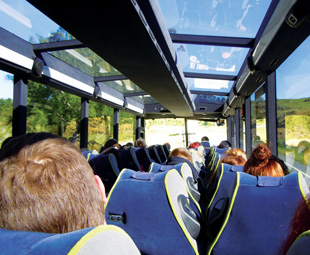Developing diligent drivers

From drivers of minibuses to those of coaches, the bus industry has a number of exciting opportunities for new and experienced drivers alike. Learning both on the road and in the classroom, good training courses teach drivers how to operate safely, efficiently and effectively in this profession. CLAIRE RENCKEN investigates
As stated by Vic Oliver in his monthly column, Vic’s View, on page 6, drivers are the front line of a company and reflect that company’s image, so it is imperative that they have the right attitude. Of course, in terms of buses and coaches, drivers are also responsible for the safety of all their passengers. So it is crucial to employ the right drivers, and then to ensure that they receive the best possible training.
Scania South Africa, for example, provides professional level driver training that covers a wide range of situations and vehicle types. Driver training ensures that the customer gains longer service life from the vehicle, lower operating costs, lower fuel consumption – and improved trip turn-around-time due to efficient use of engine torque and down-hill speed control.
Safety is a high priority and drivers are trained in all aspects of vehicle and road safety. The service development department provides driver training for Scania all-wheel-drive vehicles, manual-transmission and opticruise-transmission vehicles.
In addition, Scania places major emphasis on health and safety. It is with this in mind that all driver training programmes include HIV/Aids awareness programmes.
The common delivery platform for Scania’s driver training includes:
Vehicle technology and environmental issues:
• Emissions and their environmental impact
• Vehicle technology
• Daily inspection and maintenance
Driving technique and road safety:
• Factors affecting fuel consumption
• Defensive driving
• Driving technique
Load positioning and securing
Risk awareness:
• Personal risks
Emergency situations
Service and logistics
Application of laws and regulations:
• Legislation regarding transportation of goods
• Common regulations.
Mercedes-Benz South Africa (MBSA) also has various driver training programmes. These extend beyond the usual services provided to customers and offer tailor-made, high-quality training programmes to contribute to the development of their drivers. After all, a trained driver is safer driver. Having well trained drivers creates a safer experience for all road users.
MBSA offers driver development, which is of significant importance in the transport industry, as the latest technology on modern commercial vehicles requires upgraded driver skills. FleetBoard Professional Training provides tailor-made courses and programmes to achieve this goal, so that customers can benefit from optimal utilisation of the vehicle and improved efficiency of their fleets.
The driver training offered provides participants with vital guidelines and information about economical driving. Drivers learn how to reduce fuel consumption without any noticeable drop in performance. Meanwhile, the safety training programme teaches drivers how to master dangerous and extreme situations by practising emergency stops, cornering and many other important exercises, and ensures that drivers are fully prepared for whatever driving hazards they
may encounter.
Objectives of the MBSA training:
• To provide quality training and services that will foster personal growth and enhance driver skills;
• To facilitate career path development for drivers and transport-related personnel;
• To contribute to a safer road environment;
• To supply driver orientation training with every new commercial vehicle purchased;
• To consult with transport operators regarding driver competency, training requirements and driver skills development.
Analysing driver behaviour for better risk management
Telematics is proving to be an essential weapon in the monitoring of non-approved driver behaviour – from digressions off approved routes, to speeding and harsh braking or accelerating. This is according to John Edmeston, managing director of Cartrack, a market-leading vehicle tracking and recovery, fleet management and telematics service provider.
“In 2006 Cartrack widened the scope of its target market to include full telematics services with a powerful web-based system that enables fleet managers to optimise the productivity of their fleet and most notably, monitor the behaviour of their drivers,” he explains.
“For the fleet owner, telematics is a powerful means to manage the behaviour of drivers, and in turn, better manage insurance premiums through risk-management strategies that allow the fleet manager to pinpoint problematic behaviour with absolute precision,”
says Edmeston.
Cartrack has a significant edge when it comes to insurance telematics as reporting back to the client and insurer is done in real time, rather than in delayed weekly or monthly reports. So there is a tangible and immediate means to actually influence driver behaviour for better at the point of transgression – drawing the drivers’ attention to the fact that their driving behaviour puts them at risk of an accident, and, secondly, that they could face implications in terms of their insurance cover if they continue with their non-approved driving behaviour.
“One just has to think of the potential to reduce our road accidents and death tolls by incentivising good driving behaviour and correcting poor driving habits at the point of transgression. In a country where 14 000 people die each year on our roads, telematics could soon evolve to the point where it plays a vital role in road safety and entrenching the right driving behaviours,” adds Edmeston.
Of course, fear of getting into trouble should not be the main motivating factor for drivers to be the best that they can be – empowering them and helping them become better at their jobs gives them more confidence and pride in their work, automatically making them more cautious and less prone to accidents.
Published by
Focus on Transport
focusmagsa




